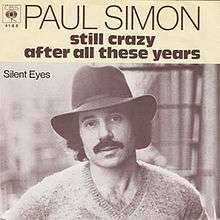Still Crazy After All These Years (song)
| "Still Crazy After All These Years" | ||||
|---|---|---|---|---|
 | ||||
| Single by Paul Simon | ||||
| from the album Still Crazy After All These Years | ||||
| B-side |
"I Do It For Your Love" (US) "Silent Eyes" (Europe) | |||
| Released | March 26, 1976 | |||
| Format | 7" | |||
| Genre | ||||
| Length | 3:24 | |||
| Label | Columbia | |||
| Writer(s) | Paul Simon | |||
| Producer(s) |
| |||
| Paul Simon singles chronology | ||||
| ||||
"Still Crazy After All These Years" is a song by the American singer-songwriter Paul Simon. It was the third and final single from his fifth studio album of the same name (1975), released on Columbia Records. Though the song briefly reached the top 40 of the Billboard Hot 100 in the U.S., it was a bigger hit on the magazine's Easy Listening chart, where it peaked at number four.[1]
Composition
"Still Crazy After All These Years" begins with the singer singing that "I met my old lover on the street last night."[2] The "old lover" has been variously interpreted to be either Simon's ex-wife Peggy Harper, from whom he was recently divorced, his former girlfriend from the 1960s Kathy Chitty, or even Simon's former musical partner Art Garfunkel, who appears on the song that follows 'Still Crazy After All These Years" on the album.[2][3] After sharing a beer, the singer and the old lover part ways again.[4] The singer notes that he is "not the kind of man who tends to socialize" but rather leans "on old familiar ways" and is "still crazy after all these years."[4] The lyrics acknowledge a nostalgia for the past, but also subtly suggest that once the sweet nostalgia is gone, it is replaced by loneliness and even bitterness.[2]
The song features the Muscle Shoals rhythm section: Barry Beckett (fender rhodes), David Hood (bass) and Roger Hawkins (drums). The saxophone, played by Michael Brecker, emphasizes the jazz character of the song.[2][5] Music theorist Peter Kaminsky analyzed how the key progression of the introduction to "Still Crazy After All These Years" anticipates the key progressions throughout the album.[5] The song has an AABA form, with the first, second and fourth verses sharing the same basic melody.[5] The first and second verses are primarily in the key of G major, although there are some unexpected harmonies that differ between the verses.[5] The key of the third verse, the B section, is never resolved.[5] G major returns in the final verse, but modulates to the slightly higher key of A major, which according to author James Bennighof gives "a faint sense of slightly demented triumph to the singer's declaration that he wouldn't be held responsible for his potential mayhem."[5][6] Music critic Walter Everett considers this modulation to reflect the singer's "unpredictable emotional and mental state."[6]
Reception
Rolling Stone critic Paul Nelson considered "Still Crazy After All These Years" to be the best song on the album.[7] He praises the "poignancy and openness" of the first verse and Brecker's passionate sax solo, and the fact that the song demonstrates "the fierceness of [Simon's] will."[7]
Simon has performed the song twice on the late-night comedy series Saturday Night Live. He first performed the song during the show's October 18, 1975 episode, during its first season, second season in a turkey costume shortly before Thanksgiving 1976, and again for the Saturday Night Live 40th Anniversary Special in 2015.
Charts
| Chart (1976) | Peak position |
|---|---|
| Australia (Kent Music Report)[8] | 10 |
| Canada (RPM)[9] | 38 |
| Canada MOR Playlist (RPM)[10] | 2 |
| US Easy Listening (Billboard)[11] | 5 |
| US Billboard Hot 100[12] | 40 |
Notes
References
- ↑ "Still Crazy After All These Years awards". Allmusic. Retrieved 2014-07-05.
- 1 2 3 4 Charlesworth, C. (1997). The Complete Guide to the Music of Paul Simon and Simon & Garfunkel. Omnibus Press. p. 74. ISBN 0711955972.
- ↑ Eliot, M. (2010). Paul Simon: A Life. John Wiley & Sons. p. 142. ISBN 9780470900871.
- 1 2 Fineman. M.A. (2009). "Equality: Still Illusive After All These Years". In McCain. L.C.; Grossman, J.L. Gender Equality: Dimensions of Women's Equal Citizenship. Cambridge University Press. p. 251. ISBN 9780521766470.
- 1 2 3 4 5 6 Bennighof, J. (2007). The Words and Music of Paul Simon. Greenwood Publishing Group. pp. 70–71. ISBN 9780275991630.
- 1 2 Everett, W. (1997). "Swallowed by a Song:Paul Simon's Crisis of Chromaticism". In Covach, J.; Boone, G.M. Understanding Rock: Essays in Musical Analysis. Oxford University Press. pp. 120–126. ISBN 9780199880126.
- 1 2 Nelson, P. (December 4, 1975). "Still Crazy After All These Years". Rolling Stone Magazine. Retrieved 2014-07-05.
- ↑ Kent, David (1993). Australian Chart Book 1970–1992. St Ives, NSW: Australian Chart Book. ISBN 0-646-11917-6.
- ↑ "RPM100: Singles" (PDF). RPM. Ottawa: Library and Archives Canada. 25 (12). June 19, 1976. Retrieved November 12, 2015.
- ↑ "The Programmers' MOR Playlist" (PDF). RPM. Ottawa: Library and Archives Canada. 25 (14). July 3, 1976. Retrieved November 12, 2015.
- ↑ "Paul Simon – Chart history". Billboard. Prometheus Global Media. Retrieved November 11, 2015.
- ↑ "Paul Simon – Chart history" Billboard Hot 100 for Paul Simon. Retrieved November 11, 2015.
Sources
- Bennighof, James (2007). The Words and Music of Paul Simon. Greenwood Publishing Group. ISBN 978-0-275-99163-0.
- Eliot, Marc (2010). Paul Simon: A Life. John Wiley and Sons. ISBN 978-0-470-43363-8.